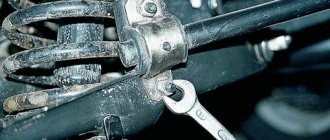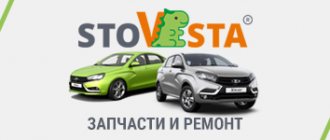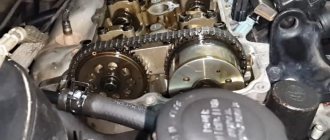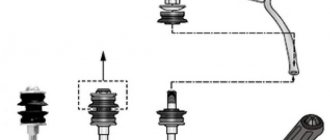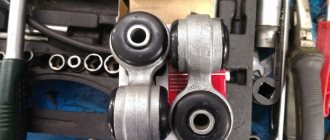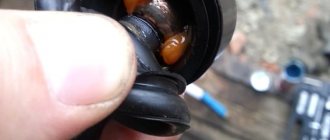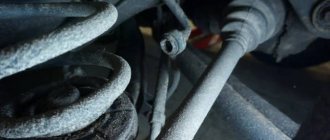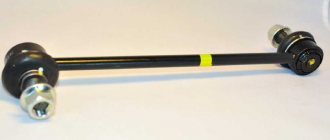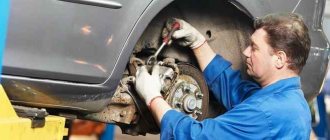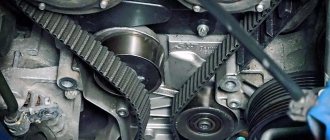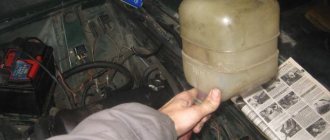The design of the car contains parts and devices that provide protection against instability and easy rollover in the event of a sharp turn. Stabilizer links are devices designed to create lateral stability of a car. That's why they are called anti-roll bars. These are important elements of the machine’s design, so you need to monitor them and be able to determine from the signs of malfunctions which malfunctions are in which unit.
Design and principle of operation
The stand is a rod with a length of 5 to 20 centimeters. The rod has hinges at both ends for mobility. The following options can be installed as hinge joints:
- two ball joints;
- stabilizer joint and bushing;
- two bushings;
- on one side there is a hinge, and on the other there is a thread.
As a rule, hinge parts are welded to the rod at a right angle (90 degrees). At the point where the tip attaches to the metal rod, it has a neck (thin end). This was done on purpose, that is, they weakened the structures in this particular place, so that if the permissible maximum loads were exceeded, the device stand would break in exactly the thinned place. This method can be called a mechanical fuse. If the strut had broken in any other place, it could have pierced the bottom of the car, causing harm to the driver or passengers.
This thoughtful design of the racks allows you to protect yourself from unnecessary problems. There is no need to complain that the racks often fail; they are specially made not too thick. Non-original racks are often larger in diameter than the original ones. They will last longer, but safety in this case is reduced.
The most popular type of racks are racks with ball joints. A device of this type of rack includes a steel ball pin and a plastic seat with a lubricant that has special temperature and dynamic characteristics. A metal or plastic cap is pressed onto the top of the finger.
To protect against dust getting into the hinge joints, sealed rubber boots with lubricant are always installed. Such a simple part as a boot significantly increases the service life of the device and the moving mechanism protects against loss and contamination of lubricant. The main property of the lubricant for the hinges under the boot is frost resistance so that it does not thicken in severe frosts.
To better understand how stabilizer struts work, you need to understand that the struts are not rigidly connected to the stabilizers, that is, they have some mobility relative to each other. During a turn, the car begins to tilt (natural roll), and at this time only forces act on the car body, and forces act on the suspension, which try to straighten the body. If the roll force is much greater, then there is a risk of breaking the associated parts: the stabilizer and the hub eye. It turns out that the stabilizer link is a damper that equalizes oppositely directed forces. But, since the force that wants to overturn the car (during a sharp turn) and the force that is against it, both put pressure on the stabilizer bar, which is why the hinge joints of the strut are gradually destroyed.
There are manufacturers who make stabilizer struts with self-adjustment. For example, on the Nissan Patrol GR (Nissan Patrol GI ER) an electronic anti-roll bar is installed, that is, the electronics can turn off the stabilizer.
There are also cars, often SUVs, in which the operation of the stabilizers is regulated by an electronic control unit (ECU).
Typical anti-roll bar
To understand how a stabilizer works, it’s easier to immediately study its structure:
Suspension stabilizer in modern cars
The couplings 6 allow the tubular bracket 5 to rotate freely. The bracket, in turn, is connected to the shock absorbers, but not through couplings or hinges, but through struts 3. Each strut or rod is the stabilizer strut discussed in the title.
Not everyone understands why the front and rear stabilizer struts are needed, and why the bracket cannot be connected directly to the shock absorbers. The answer seems simple: if you do this, the shock absorber rod will not be able to move in the longitudinal direction. Draw the whole diagram and you will understand what we are talking about.
Note that the shock absorber strut plays an important role in the design of a modern suspension. The shock absorber itself not only dampens vibrations, but also serves as a guiding element. Roughly speaking, the entire suspension “walks” along the shock absorbers, but if you remove the stabilizer links, little will change. Unless the roll angles observed in turns increase. There were cases when the rod broke while driving, and the owner did not notice the deterioration in controllability.
Malfunctions of the stabilizer struts
Malfunctions can be identified by knowing the symptoms and signs of malfunction. If problems occur in the operation of the stabilizer struts, the following symptoms appear:
- There is a characteristic knocking noise when driving on rough roads. This symptom occurs on machines that have racks with ball joints. For example, the stabilizer knocks when moving over a speed bump (an artificially created unevenness in the road to reduce speed).
- While driving on a flat road, the car pulls to the left and then to the right.
- During a normal turn, the car rolls (tilts) more than it was before.
- There is a lateral swaying of the car body when driving on a flat road.
Causes of breakdowns of stabilizer struts
The most vulnerable element in this assembly is the hinge joints. The reasons may be the following:
- The boot has ruptured, causing dust to get onto the lubricant and into the joint itself.
- The ball pin race has worn out. In this case, the ball pin dangles in the seat.
Repairing racks is a complex process. For this you need good factory equipment. You can simply replace the worn part, ball pin or bushing. The cost of such work is high. Therefore, it is better to buy new stabilizers. It is not necessary to buy original ones, you can buy regular ones, they also work well.
The influence of struts on the car
The most noticeable effect of the front and rear stabilizer struts on the car is when the owner decides to do the suspension tuning with his own hands. The comfort, handling and safety of the car are changing. The various options that car owners often choose from are discussed in the table below.
Table - Effect of stabilizer struts on the car
| Modernization | Effect on the car |
| Installation of a front stabilizer and standard struts on a car, the basic configuration of which does not have these elements, but is present on more expensive versions | Handling improves at high speeds. Rolls are slightly less. There is no too noticeable effect. |
| Installing the rear stabilizer and knuckles | Reducing rear end drift on high-speed turns. Reduced roll by 20-30%. Occasionally there is hanging of the rear wheels. Turn-in is smoother and can be performed at high speeds. |
| Installing only the rear stabilizer with struts without the front one or significantly strengthening it | Strong roll of the front of the car in fast turns. Throwing a car out of the road. |
| Installation of more powerful racks that differ significantly from standard ones | Increased cornering speed and noticeable improvement in handling. Installed reinforced struts without upgrading the remaining suspension elements are sources of excessive loads on other chassis parts, which is why they quickly fail. For example, a stabilizer bushing may require replacement after 10-15 thousand km. |
| Installation of cheap/weak stabilizer links | Mainly affects only the resource and reliability of the knuckles. Such a repair kit rarely lasts long. In most cases, a decrease in the mechanical strength of the struts does not in any way affect the comfort, handling and dynamics of the car. |
Most car owners believe that reinforced struts negatively affect the car. It is impossible to achieve the handling characteristics of sports cars by upgrading the knuckles, and the comfort of overcoming bumps decreases as the chassis becomes stiffer. Particularly dangerous are homemade knuckles, which, according to the assurances of the owners, have no wear. Such eternal racks cease to perform a “safety” function due to increased mechanical strength and do not meet safety requirements. Any excessive load causes significant damage to the suspension, which the standard knuckle could have prevented by breaking.
How to check stabilizer links
You can find out the condition of the racks with ball joints very simply:
- To do this, you need to stand on the side of the car and rock it. If the car easily rocks sideways, this means that the stabilizer strut joints are out of order. If the strut itself is faulty, a knocking sound will be heard in the wheel area.
- Turn the wheels as far as possible in one direction. Now one rocks the car sideways, the second one touches the stabilizers and feels if there is any play. There should be practically no play.
- Check the condition of the anthers. If it is torn or not at all, you will have to replace it. An unprotected hinge mechanism will not last long.
If the car has stabilizers installed not with balls, but with bushings, then it is even easier to check. It is enough to see if the rubber has worn off on only one side. If the tires are worn out, replacement is required. It is better to check tire wear when the wheels are inflated. See what the tire pressure should be for your specific make and model of car. Basically, for passenger cars, the pressure is set at 1.9-2 Atmospheres.
To save money, you should not immediately go to a service station and carry out paid diagnostics. You can do some easy diagnostic tests yourself. In addition, not all people are honest; they can exaggerate and replace what is not needed.
We identify all problems ourselves
It has already been said here that the most unreliable, most “fragile” part of the stabilizer is the struts. This is done on purpose so that in the event of an accident, the least damage can be caused. Let's name the main symptom accompanying the breakdown of stabilizer struts or rods. This is a dull knock that occurs when driving over any irregularities, potholes and even small stones. And sometimes the car begins to roll out of the roll worse - conclude that one of the struts has already been torn off. But knocking will be observed in 90% of cases! It can come from both the front and rear suspension.
Let's say there is a bushing in the design of the stabilizer struts (photo 2 in Chapter 2). It will then be more difficult to identify the defect: even if the bushing is destroyed, knocking does not always occur. More often the sound will be muffled, quiet, and generally difficult to hear.
Creaks and crunches, especially when cornering, usually indicate the destruction of the boot. But the defect itself, we repeat once again, is rare. The hinge shown in the photo will begin to deteriorate over time. And the creak should then turn into a grinding sound.
Ball joints inside the struts
How to change stabilizer links
To learn how to change these racks, it is enough to make the change once as an assistant. Obviously, depending on the make and model of the car, the design and replacement methods are slightly different.
Necessary tools for replacing stabilizer struts:
- jack;
- keys;
- hexagons;
- mount.
The front pillars are longer than the rear ones. You should not change only one strut, you need to change either both front ones or both rear ones.
During replacement, the machine axle must be hung and loaded, that is, after jacking up and removing the wheel, a stand must be placed under the ball joint. In this case, the stand and stabilizer will be in a relaxed state.
During repairs, you need to be careful with the anthers so as not to tear them. If they require replacement, it is better to replace them immediately.
Signs of faulty parts
It is not enough to understand what stabilizer struts are; you also need to detect their malfunction in time, because inoperative elements negatively affect the controllability of the car. Worn parts can be determined by the following signs:
- The car body begins to roll more when cornering.
- It becomes noticeable that the car describes a large arc when going around an obstacle.
- During intense acceleration or sharp braking, a slight skid of the body is felt.
- When the steering wheel is turned sharply or speed bumps pass, a dull knock is heard from the front part of the suspension.
One of the most reliable ways to diagnose struts is to conduct a “moose” test . The idea is to go around an unexpectedly appeared obstacle – a so-called “moose” – at a speed of 40-50 km/h. You need to choose a traffic-free area and place a couple of plastic bottles in a convenient place. Then accelerate to the specified speed and try to quickly drive around them.
If during the maneuver the front part of the vehicle rolls heavily and “yaws” to the sides, and a distinct knock is heard from the chassis, then the struts must be replaced immediately. In some cases, the car describes such a wide arc while driving around that it can go into a skid.
You can make sure that stabilizer links are needed for replacement using the traditional diagnostic method - manually rocking the parts. To do this you need to do the following:
- Secure the car with the handbrake.
- Turn the front wheels all the way so that you can reach the right or left pillar with your hand.
- Grasp the rod near the ball pin and actively swing it in different directions. To be sure, you should pry the hinge with a mounting spatula, this will reveal the play inside the bushing.
If noticeable play is detected, the element needs to be replaced . Due to poor roads in the post-Soviet countries, the racks constantly experience high loads and rarely last more than 20 thousand km. Fortunately, these parts are inexpensive and change quite quickly. If you wish, you can install new parts yourself, having the usual set of metalwork tools, a jack and a puller for pressing out the ball pins.
Worn stabilizer links do not prevent further movement, but only worsen the vehicle's handling. Even a finger that has jumped out of the sleeve allows you to move on under your own power. This is taken advantage of by careless motorists who do not pay attention to the suspicious behavior of the car and the knocking of the suspension. Such driving is dangerous and at high speed can lead to loss of control and an accident with unpredictable consequences.
Which racks to choose
Now you can buy plastic stabilizer struts. They have less strength, are destroyed if something happens and do not cause harm to other parts and passengers of the car.
Length plays an important role when choosing racks. You should pay attention to the length. You also need to look at the packaging, it says what cars they are suitable for. Stabilizers and struts are interchangeable for models of the same brand, for example, for Ford Focus, Ford Fiesta, Ford Escort, Ford Ka 1995-2001, these parts are interchangeable and fit together .
What it is
An anti-roll bar is part of almost any type of suspension. It looks like an inconspicuous pipe, but it is responsible for traffic safety, car control and comfort in the cabin.
This does not have to be direct labor . Its shape can be quite bizarre. This is due to the layout of the chassis and the decoration of the engine compartment of the car. Its smooth lines go around the components and assemblies. It must connect the two parts of the machine in the transverse direction. Roughly speaking, it connects the left and right elements of the car’s suspension.
The anti-roll bar is made of spring steel, the same material from which springs and leaf springs are made. It has sufficient elasticity and is capable of bending around its axis.
That is, if you take it by the opposite ends (shoulders) and twist them, it will twist. Of course, it is difficult to do this with your hands, but the mass of the machine will be enough for this.
Rating of stabilizer struts
Below is a list of stabilizer struts by rating:
- Lemforder (Lemforder). Country: France. Such racks are purchased from them by manufacturers General Motors, Mitsubishi, Toyota, Opel, Volkswagen, Mersedes-Benz, Audi, BMW, Ford, Volvo, Fiat and some other brands. Reputable quality and good resource.
Reviews (+) Reviews (-) Lehforbeck tested it in an Opel Omega B, Opel Vectra C, Huyndai Santa Fe New. Had no problems with them either. Lemforder is not suitable for Japanese cars. I can easily drive more than 35 thousand km. No problem. After 0.5 years of operation, the Lempherder began to knock. - Topran (Topran). Country: Germany, China. The country code will tell you where the part was made.
Positive reviews Negative reviews For the money this is a good option. I haven't found any problems with the Opel Omega B yet. They started knocking after 5 thousand km. The stand is a consumable item. Therefore it is necessary to change often. Over 50 thousand km there are no squeaks or knocks. - Sasic (Sasik). Country: France (Normandy). Renault (Renault), Peugeot (Peugeot), Citroen (Citroen) install them on their cars. The cost is not high, the quality is good.
Good feedback Bad reviews Chinese analogs lasted 10,000 km. We installed Sasik until we drove 15,000. After a short run of 5,000 km, these stabilizers sat down. Not very expensive and they last. They burst within 2 weeks. - GMB. Country: Japan. The main consumers are Japanese and Korean cars: Toyota, Nissan, Mitsubishi, Hyundai, Kia, Renault, Suzuki, GM.
Good feedback Bad reviews GMB for a mileage of 35 t.km showed no problems. No negative reviews found The old Pajero (Pajero) had no problems with stabilizers. - CTR. Country: South Korea. Among the consumers are the following car factories: Ford, Kia, Hyundai, GM, etc.
Positive reviews Negative reviews I've only recently been using it. For 2 months there are no crunches or squeaks. When there is nothing else to bet, it will do. Withstands cornering loads well. After 10 thousand kilometers they began to knock. Perhaps it was a fake. - Sidem (Sidem). Country: Belgium. Popular brand. It has 80 factories around the world.
Positive reviews Negative reviews If you can buy a Belgian-made one, there will be no problems. Nowadays you can find them made in China and they don’t last long. . - Links Master. Country: Russia (Tver). Prices are lower than their counterparts. No reviews have been left yet. If you used it, write in the comments and I’ll add it.
Whether the reviews are real online or not is unknown. But everyone should understand that how long the stabilizers and struts will last depends on the style and manner of driving.
Helpful advice: do not brake on bumps (for example, on a speed bump). You need to brake before the obstacle. This simple action can extend the service life of many parts of the car's chassis.
Stabilizer malfunctions, their symptoms, condition check
The more elements there are in the suspension units, the higher the likelihood of a malfunction occurring in it. Here are the main problems with stabilizer struts:
